Math Topics
Learning Support
Professional
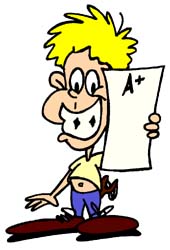
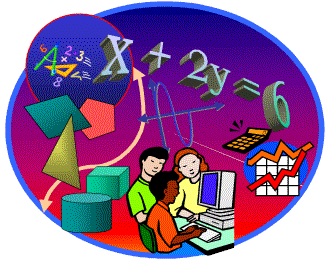 Our
collection of Math Resources has multiple pages designed for teaching
within specific grade bands. You'll also find valuable collections of
support and enrichment resources that will benefit all learners.
Our
collection of Math Resources has multiple pages designed for teaching
within specific grade bands. You'll also find valuable collections of
support and enrichment resources that will benefit all learners.
Math Resources (Page 1): K-8 Basic Mathematics and Skills Development, plus apps for mobile devices
Math Resources (Page 2): High School Subject Specific Resources, including apps for mobile devices: Algebra and Pre-Algebra, Geometry, Statistics, Probability, Trigonometry, Precalculus and Calculus
![]() Math Resources (Page 3): K-12
Supplementary Collections on this page include:
Math Resources (Page 3): K-12
Supplementary Collections on this page include:
Math Resources (Page 4): Enrichment and Extra Help: Math Contests, Competitions, Challenges, and Camps; Study Skills and Homework Help, plus tips for parent involvement; and Dictionaries, Glossaries, Reference Sheets, and Math Encyclopedias
Math Resources (Page 5): Lesson Plans and Worksheets, Design and Manage Your Own Lesson Plans, and Publishers' Textbook Support Sites
Math Resources (Page 6): Resources for Podcasts and Videos, the Flipped Learning Model, and Whiteboards, including tips on using the flipped learning model, creating better instructional videos, and using whiteboards
Use the Fields of Mathematics Interactive Mind Map by Antonio Gutierrez of GoGeometry.com to introduce your learners to the broad field of mathematics. This mind map elaborates on multiple categories within seven fields: the mathematics of quantity, space, change, structure, foundations and philosophy, discrete mathematics, and applied mathematics. This is a great find!
BrainPOP produces educational animated movies and is award winning. K-12 movies address science, technology, health, math, and special topics, including online safety. The online math movies include topics in algebra, geometry, data analysis/probability, problem solving, measurement, and numbers/operators. There are homework help, puzzles, activities, prizes, and more for registered users.
FactMonster.com is an award winning site that features an atlas, almanac, dictionary, encyclopedia, and individualized homework help. Students can get facts on a range of subjects including math, the world and news, U.S., science, sports, people, and more. There are games and quizzes also. Among press releases is the March 2001 recognition in the NCTM News Bulletin, WebBytes, which highlighted the site as a reference source.
LearnAlberta.ca provides multimedia online resources for K-12 in several content areas, accessible for all learners. Don't miss the use of audio, video, animations, and interactivity in the mathematics course materials.
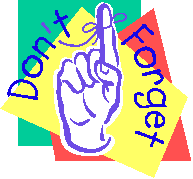 Math
Mnemonics from OnlineMathLearning.com contains math mnemonics that help
students remember math conventions, algorithms, definitions, techniques, and
formulas. These are categorized by pre-algebra, algebra, geometry, and
trigonometry. [Note Education World has
additional math mnemonics.]
Math
Mnemonics from OnlineMathLearning.com contains math mnemonics that help
students remember math conventions, algorithms, definitions, techniques, and
formulas. These are categorized by pre-algebra, algebra, geometry, and
trigonometry. [Note Education World has
additional math mnemonics.]
Math Power is a must see web site that provides information about basic math, algebra, study skills, math anxiety, and learning styles. Although the site addresses the needs of community college adult learners, it has appeal for middle school and secondary math students and teachers.
Nick's Mathematical Puzzles are for students grades 9 and upward. Nick Hobson addresses geometry, probability, number theory, algebra, calculus, and logic. Hints are provided, along with answers, fully worked solutions, and links to related mathematical topics. Many of the puzzles are elementary in their statement, yet challenging. There are 160 puzzles in this collection. See the index for titles of those.
A key feature of the site is the detailed exposition, from first principles, of the puzzle solutions. Some of the puzzles are used to showcase particular mathematical concepts. Further references are provided with many of the solutions. The site is designed with accessibility in mind.
OnlineMathLearning.com is a real find! It contains math help and learning resources for arithmetic, algebra, geometry, statistics, probability, set theory, trigonometry, matrices, SAT and ACT test preparation, worksheets, games, trivia, and links to related resources. Of particular value are the videos that accompany various topics. Resources are identified for Common Core math standards.
Platonic Realms for secondary and post-secondary students features a "must-see" interactive mathematics encyclopedia, which can be browsed at elementary and advanced levels. Topics include basic mathematics, algebra, analysis, biography, calculus, discrete math, history, economics, geometry, graph theory, number theory, statistics, trigonometry, and math quotes. There is an extensive link library to instructional resources, K-12 and university math departments, institutes, journals, societies, business/commercial math sites, and selected personal pages. View the mathematics art of M.C. Escher.
Teaching Treasures offers online interactive practice in K-10 mathematics topics with helpful explanations: addition, subtraction, multiplication, division, algebra, measurement, problem solving, shapes, space, reading a clock, and more.
Tecmath on YouTube contains multiple videos, each about 10 minutes or less, on a variety of math topics: geometry, trig, statistics, puzzles, problem-solving tricks and short cuts, fractions, and more. The collection is extensive and also includes playlists.
TES Teaching Resources contain an extensive library of free teaching resources in multiple areas created and uploaded by teachers in the TES community. Classroom materials include lesson plans, videos, PowerPoints, games, puzzles, worksheets, tutorials, interactives, and whiteboard resources. Math resources are easiest found by accessing the collection of primary and secondary resources, then narrow your search by a grade level or subject. This site is based in the UK and highly rated--do have a look.
U.S. Department of Education is a comprehensive site for preK-12 and higher education resources, policy information, grants and funding, research and statistics, and more.
Math Matters includes a brief look at how mathematics has influenced modern life. It highlights the top twenty technological advances of the twentieth century, and explores the role of mathematics in bringing these innovations to reality. Consider electrification, highways, electronics, water supply and distribution, household appliances, petroleum and petrochemicals, airplanes, spacecraft, high performance materials, air conditioning and refrigeration, nuclear technology, radio and TV, computers, imagining, telephones, the internet, health technologies, agricultural mechanization, laser and fiber optics, and automobiles. The events and historical influencers are online and a downloadable poster is available.
 Math
occurs in so many careers and in daily life. According to the U.S.
Bureau of Labor Statistics (2020), "Employment in math occupations is projected to grow 27 percent
from 2019 to 2029, much faster than the average for all occupations, and will add about 56,100
jobs. Growth is anticipated as businesses and government agencies continue to emphasize the use
of big data, which math occupations analyze." Here are some examples for you:
Math
occurs in so many careers and in daily life. According to the U.S.
Bureau of Labor Statistics (2020), "Employment in math occupations is projected to grow 27 percent
from 2019 to 2029, much faster than the average for all occupations, and will add about 56,100
jobs. Growth is anticipated as businesses and government agencies continue to emphasize the use
of big data, which math occupations analyze." Here are some examples for you:
People who work in agriculture try to maximize produce and would need to know about mixture problems. What's the right amount of seed to use, or fertilizer, pesticides, water?
Accountants/Bankers/and Financial businesses use spreadsheet packages. Who's writing the formulas? This is an algebra skill. Profit/loss translates to knowledge of percents and decimals. There are algebraic equations involving time and interest rates for calculating mortgage payments.
Airport air traffic controllers, pilots/aviators, and aviation mechanics use math. The air traffic controller needs to determine which plane should land first on a runway based on how fast the plane is traveling and how far it is away from the airport, and they need to determine which can take off first. They need to know about wind speed and direction, and at what altitude a plane should fly. Aviators need knowledge of the science of air pressure, drag, lift and velocity, and using formulas to calculate aircraft speed. Pilots also need to know a lot of math including basic arithmetic, algebra, trigonometry, geometry, calculus, physics, and so on. As examples, it is much more than determining how long a trip will take given distance to a destination and speed of the plane. They must consider how much fuel their planes need for a trip, so they need to also consider weight of passengers and what else the plane is carrying, and weight of the fuel. When in flight, they must know when to start to decend a plane, and how fast to decend and at what angle of descent. The aviation mechanic uses math tools to ultimately ensure the plane is safe for flight. For more information, read What Kind of Math do Pilots Use?.
Art and Design of any kind (think people in marketing, too) require visualization. Many of the pleasing designs use "The Golden Ratio, Phi, 1.618." See: https://www.goldennumber.net/ and https://mathworld.wolfram.com/GoldenRatio.html
Architects use sophisticated software to build online virtual models of buildings, houses, and so on. They certainly need visualization skills--those spatial aspects students study in math, which they might practice using online virtual manipulatives. Certainly architects need understanding of geometric and algebraic concepts for making physical models of the real thing. Scale drawings rely on accurate use of fractions and decimals.
Artificial Intelligence careers rely on mathematics. Sakshi Gupta at Springboard (2022, March 7) noted 10 examples, including machine learning engineers, data scientists, business intelligence developers, big data engineers/architects, software engineers, data analysts, robotics engineers, and natural language processing engineers.
Athletes can improve their performance by knowing about mathematics (e.g., as it relates to motion, vectors, geometric shapes, nutrition/health, torque, etc.)
Auto industry: How about all the math used in the auto industry? Car designers use math. Cars contain sophisticated computers. Even now, crash tests are done with simulations.
Biologists use statistics and probability.
Builders need to measure accurately to cut those boards, pour those floors (think proportions in getting cement to the right consistency--too much water and the structure breaks). That's where knowledge of fractions and decimals comes in. They would need to know about areas, volumes, slopes, angle measures, distance, ratios, and so on. They need skills to calculate how much of a product to buy for the job they are doing, and then its total cost.
Climatologists use "mathematical skills in collecting climate data, investigating climate indicators, and making predictions regarding climate patterns. They may use computer models to study how Earth's climate changes with time, and sophisticated computer software programs that assist them in modeling the Earth's climate and check that data against known information. They conduct research to determine if humans are affecting Earth's present and future climate." Source: WeUseMath: Climatologist from Brigham Young University.
Cooks, even in the big restaurants, need measurement skills, and proportions for converting recipes for larger or smaller quantities. But there are software packages to help with that and databases for storing those recipes and spreadsheet packages for inventories, profit/loss, and so on. You need to understand formulas in algebra to design those spreadsheets.
Cybersecurity is a top career field in high demand.
Data analysts (e.g., data scientists, statisticians, actuaries) are almost everywhere and are employed in a number of careers, such as traditional technology firms, consulting, banking/finance, credit bureaus, the health industry, retail businesses, education, e-commerce and so on. Many of those have a math and science background. Learn more in Data Analyst: Career Path & Qualifications by Greg Depersio (2020).
Engineers play a role in the design and modification of products we use. A civil engineer, for example, would be concerned about the amount of weight a road or bridge can handle under a variety of weather conditions. Algebra would help with those calculations in their design.
Fitness trainers can use algebra to help determine a ratio of diet to exercise for achieving a desired weight and maintaining it.
Forensic scientists analyze evidence from crime scenes for a court of law. Taking precise measurements (e.g., distance, weight, volume, temperature, etc.) is an essential skill, as is proportional analysis, probability, and trigonometry. Read more in What Math is Used in Forensic Science?
Geologists and geoscientists use math models to study the earth: daily weather patterns, earthquake predictions, how glaciers are changing, the best building sites, where flooding might occur, where best to perform archeological and paleontological digs, and so on.
Math and Science Educators and others in STEM fields.
Medical doctors study the human body and must be able to properly prescribe doses of medicines, and detect illnesses. A heart doctor, for example, would rely on an algebraic equation involving heart rate and oxygen levels in the body to determine cardiac output.
Manufacturing jobs require math skills: "[T]oday's manufacturing work requires strong math skills — not just adding and subtracting, but a good grasp of fractions, decimals and basic trigonometry. And job applicants who want to go into manufacturing often don't have what it takes" (Boodhoo, 2012, para. 2). Learners who are interested in manufacturing careers might be interested in a glossary of 95 manufacturing terms provided by Propel PLM Inc.
Police apply math concepts to reconstruct vehicle crashes. Read how they do this in Building Mathematical Skills and Community Relationships Through Crash Reconstruction by Kelly Remijan (2017, November 22) in ASCD Educational Leadership.
Robotics: Robots play a significant role in today's society, including for handling hazardous materials, welding components, performing surgery, or vacuuming carpets. They are everywhere. There are self-operating robotic machines. They are used in factories, mining operations, military, healthcare, and even in the arts and sculpture. The field is growing and involves applying mathematics (e.g., algebra and geometry) in the development. Read What to Study for a Career in Robotics, a blog post by Alex Owen-Hill (2022, May 26).
Sports of all kinds keep track of player statistics. View Real-Life Math | Baseball on how an assistant general manager of a major league baseball team uses math.
Stock brokers: Anyone interested in the stock market? Positive and negative numbers are used to indicate what's happening on the market. Gain of so many points, or loss of so many points. Graphing programs (tech part) can be used to create the visual displays. Of course, knowledge of data analysis is needed.
Software developers
Space science industry--it's not just about becoming an astronaut. Florida Tech discusses Career Options for the Future Space Scientist.
Surveyors use measurement tools and GPS systems.
Tradesmen of all kinds use math to estimate job costs, and to deal with the technical aspects of their jobs.
People in the military use simulations for training. Programmers need math skills to design those environments. Angles of elevation, range, trajectories are useful to locate and hit targets. You need math to determine how much food, supplies, ammunition, trucks, equipment that troops will need and statistical estimations to determine the rate at which those will be used up.
Virtual Reality -- Think of virtual environments like Second Life -- who programs those? Everything in Second Life is designed with basic prims, which are geometric shapes that are placed and stretched to get whatever you see in the virtual worlds. Virtual reality technology is being used in medicine, engineering, and architecture to help solve problems, and it's used in the entertainment industry. For more on virtual reality in careers, view the the series of three short videos from the Stem Career Lab, located in Ohio. "Students will hear how virtual reality modeling is being used in a number of disciplines and applications. Students will learn about career paths into the Virtual Reality field and how the math and science they learned in high school will help them later in their professional lives." (Note: Extended Reality XR includes augmented reality, virtual reality, and mixed reality. Virtual reality is not the same as augmented reality. Virtual reality replaces reality (e.g. virtual worlds like Second Life); augmented reality enhances existing reality).
The list goes on and on. Animators, computer game designers, economists, special effects designers, professional photographers all use math.
The developers of Tableau, software for data visualization, stated: "Every STEM field benefits from understanding data—and so do fields in government, finance, marketing, history, consumer goods, service industries, education, sports, and so on" (Why data visualization is important for any career section). You'll find a data visualization beginner's guide with a definition, examples, and learning resources. Learn to create your own. Learn about historical examples and theory from books, access blogs on data visualization, get information on data visualization tools and software, free training videos, and more. Tableau Public is a free version to publicly share data visualizations online.
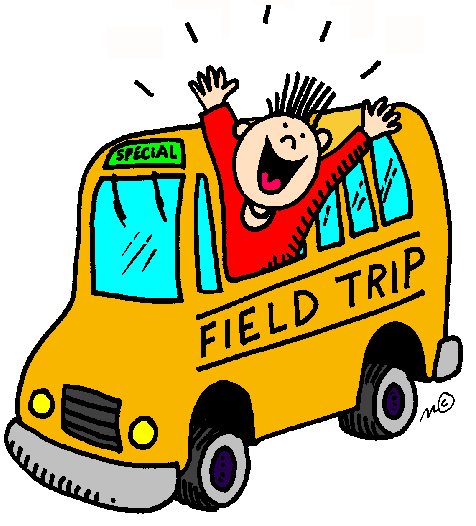 Field trips are a great way for
students to explore the use of mathematics in careers, everyday life, in other
subjects or to engage more deeply in a concept, such as the history of
mathematics, number sense; patterns, functions, and algebraic thinking;
estimation, measurement, and computations; spatial sense and geometric concepts;
and various math activities (cryptology, harvest time math, and puzzles).
Create a project in which students investigate this theme. Connect
these activities to learning outcomes/standards. Need ideas?
Visit the following resources:
Field trips are a great way for
students to explore the use of mathematics in careers, everyday life, in other
subjects or to engage more deeply in a concept, such as the history of
mathematics, number sense; patterns, functions, and algebraic thinking;
estimation, measurement, and computations; spatial sense and geometric concepts;
and various math activities (cryptology, harvest time math, and puzzles).
Create a project in which students investigate this theme. Connect
these activities to learning outcomes/standards. Need ideas?
Visit the following resources:
Discovery Education Virtual Field Trips also includes on-demand virtual field trips in multiple categories. Per the site: "Each no-cost Virtual Field Trip comes with a companion guide packed with standards-aligned, hands-on learning activities!"
Math Learning Field Trip Ideas for Homeschoolers posted at Dreambox Learning with field trip and lesson ideas for architecture, sports, museums, factory tours, and agriculture.
Field Trips Motivate Mathematicians posted at Teachers Network--consider the local bank, grocery store, restaurant, dairy, quilt shop, or train station.
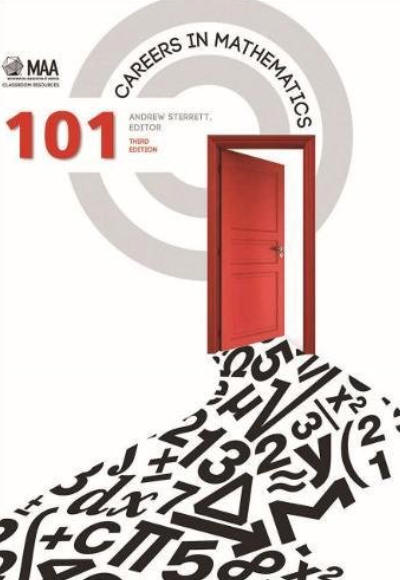 In
101 Careers in Mathematics
(3rd Edition) by Andrew Sterrett (2014), you'll actually find more than 101
careers described. Per the book's description, "Each
of the jobs presented shows real people in real jobs. Their individual histories
demonstrate how the study of mathematics was useful in landing well-paying jobs
in predictable places such as IBM, AT&T, and American Airlines, and in
surprising places such as FedEx Corporation, L.L. Bean, and Perdue Farms, Inc.
You will also learn about job opportunities in the Federal Government as well as
exciting careers in the arts, sculpture, music, and television. There are really
no limits to what you can do if you are well prepared in mathematics."
In
101 Careers in Mathematics
(3rd Edition) by Andrew Sterrett (2014), you'll actually find more than 101
careers described. Per the book's description, "Each
of the jobs presented shows real people in real jobs. Their individual histories
demonstrate how the study of mathematics was useful in landing well-paying jobs
in predictable places such as IBM, AT&T, and American Airlines, and in
surprising places such as FedEx Corporation, L.L. Bean, and Perdue Farms, Inc.
You will also learn about job opportunities in the Federal Government as well as
exciting careers in the arts, sculpture, music, and television. There are really
no limits to what you can do if you are well prepared in mathematics."
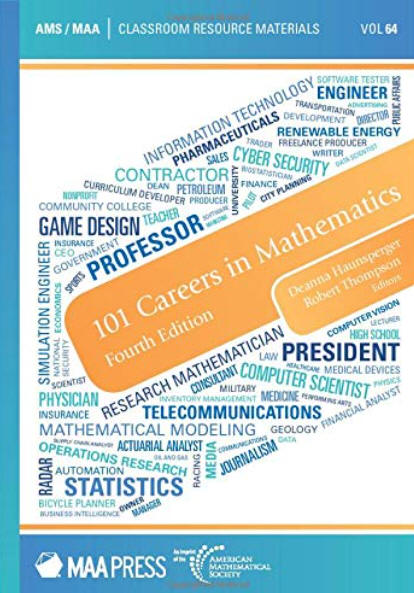 Also see
101 Careers in Mathematics (4th Edition) by Deanna Haunsperger and
Robert Thompson (2019). This book addresses what you can do with a
degree in math and includes "125 career profiles written by people with
degrees and backgrounds in mathematics." You'll find "job titles ranging
from sports analyst to science writer to inventory specialist to CEO"
and more. The "careers featured within accurately reflect current
trends in the job market." There's also information on job
searching, interviewing, and applying to graduate school.
Also see
101 Careers in Mathematics (4th Edition) by Deanna Haunsperger and
Robert Thompson (2019). This book addresses what you can do with a
degree in math and includes "125 career profiles written by people with
degrees and backgrounds in mathematics." You'll find "job titles ranging
from sports analyst to science writer to inventory specialist to CEO"
and more. The "careers featured within accurately reflect current
trends in the job market." There's also information on job
searching, interviewing, and applying to graduate school.
Resources at TechGuide.org include essays of interest, such as A Career with Numbers: A Complete Guide by John O'Donovan (2023, January 16), a K-12 STEM Guide, and Women in Tech. The site also contains a section on STEM careers.
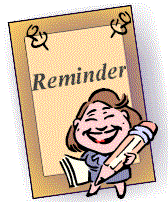 Don't
wait until high school (or even after graduating) to start exploring
career interests. Students might not be aware of the many
options available to them. According to a
2017 report from the Office of the Washington State Auditor:
Schools should "Improve career guidance given to students, and
provide it in a classroom setting in the 7th or 8th grade.
Introducing students to the many careers and jobs available after
high school could help them choose occupations that pay well but may
not require a four-year degree." (p. 3)
Don't
wait until high school (or even after graduating) to start exploring
career interests. Students might not be aware of the many
options available to them. According to a
2017 report from the Office of the Washington State Auditor:
Schools should "Improve career guidance given to students, and
provide it in a classroom setting in the 7th or 8th grade.
Introducing students to the many careers and jobs available after
high school could help them choose occupations that pay well but may
not require a four-year degree." (p. 3)
The STEM Careers Coalition provides a series of Career Profile Videos with supporting student activities "focusing on the STEM skills, knowledge, and interests needed to pursue exciting careers in the STEM industry." There are search options (e.g., grade band K-2, 3-5, 6-8, 9-12; STEM field, career field).
Pathway2Careers (P2C) includes several options for connecting math to careers: Its P2C math curriculum includes courses in Pre-Algebra, Algebra 1, Geometry, and Algebra 2 in which over 250 career pathways are explored. P2C also offers a financial literacy curriculum, career exploration curriculum for grades 6-12, explorations in career and technical education, supplemental math curriculum, and more.
American Mathematical Society (AMS) provides resources to answer the question, "What do mathematicians do?" This is an excellent place to begin discussion on the topic of "Where am I going to ever use this stuff?" The AMS also has multiple resources for building a career in mathematics within its section on The Profession. It produces Mathematical Moments, a series of one-page posters that promote an appreciation and understanding of the role that math plays in science, nature, technology, and human culture. Each poster comes with a related resource. Some feature podcast interviews with experts in the field. There is a section for high school students. The AMS is also a partner sponsoring The Big Math Network, which promotes careers in business, industry, and government to students and departments of the mathematical sciences.
American Statistical Association Careers in Statistics: Find answers to what statistics is, what statisticians do, industries that employ statisticians, how to become a statistician, and career prospects.
archKIDecture (architecture for kids) "was established in 1996 to encourage visual literacy and explain math, science and visual arts concepts through the medium of architecture" (Why section). You'll find projects, lessons, stories, architecture books for kids, and learn about the BuildIt! Traveling Exhibit for kids.
Career Cornerstone Center has numerous resources for careers in mathematics, computing, science, technology, engineering, and health fields, and assistance for career planning. The student section is particularly helpful as it addresses resources relevant for learners in middle school, high school, college/university, and graduate school. Highly recommended.
Comparitech includes top online bachelor degree programs in cybersecurity, information about the field, and delves into how to select an appropriate program to fit your needs.
Cybersecurityguide contains a list of careers in this field, programs available by state, and degree programs. Among resources is a section called Cybersecurity Math Guide, which elaborates on the role of math in cybersecurity careers.
Discover Data Science includes a section on Exploring a Career with Numbers, with links to popular careers such as a data scientist, data analyst, data architect, data engineer, business analyst, marketing analyst, data and analytics manager, business intelligence analyst, data mining specialist, statistician, and more.
Dollars Attached to a Career in Data Science is a 2019 blog post from UC Berkley School of Information. The resource provides statistics on the data science field, such as demand, salary, and number of job openings. It also includes industries in which many data scientists typically work, and highlights some well-known companies that employ data scientists.
Engineering the Future: The Educator's Guide to Building and Construction includes a "collection of lessons, activities, projects, videos, and more, broken down by grade level [K-4, 5-8, 9-12, and When I Grow Up]... to assist educators in teaching young people core areas of study by introducing them to the world of building and construction" (Overview section). Each grade level group relates building and construction to various STEM fields of study and then provides practical math projects/activities suitable for the grade level. The activities have the potential to influence career choices.
Examples of Math in Technical Fields is a set of examples provided by the Mathematics Department at the British Columbia Institute of Technology illustrating how topics in algebra, geometry, trigonometry, calculus, statistics and quality control are used in a variety of careers involving technology. You will find an appropriate math problem and its solution related to the math subject and area of technology you select. Areas include biomedical engineering, food technology, building technology, chemical sciences, civil and structural engineering, graphics and computer-aided drawing, electronics, environmental health, mechanical engineering, mining technology, nuclear medicine, occupational health, petroleum technology, prosthetics, forestry and wildlife, robotics, and surveying.
Forensics Colleges includes careers for a forensic scientist including what they do, potential specialties, colleges that offer forensic degrees, the career outlook and salary information, and commentary on the work environment.
Get Real Math and Science Videos from the NEW (NorthEast Wisconsin) Manufacturing Alliance "showcase over 80 common core skills used in the real world. The videos, produced at manufacturing companies, serve as a capstone after a skill is learned in school. Math and science skills featured are 3rd grade through high school. The lesson plans are created by math and science teachers" (Description in Thank You section). You can search videos by title, category, or keyword. For example, what does math have to do with automation or dog food or medical towels? What do canisters, coffee filters, cookies, coupons, ramps, robots, weld inspections, or waves have to do with math? Find out about these and many more examples in videos and lessons at this site.
Get the Math is a multimedia project about algebra in the real world, which is for middle and high school learners. Begin by viewing videos that show how professionals working in fashion, videogame design, music production, basketball, the restaurant business, and the special effects industry use algebraic thinking. They present challenges connected to their jobs to two teams of teens. "At that point viewers are encouraged to try the challenges themselves using interactive tools provided on the GET THE MATH website, before returning to the video to see the teams’ solutions. Students can further explore the same algebra concepts through additional interactive challenges on the website" (About section). The project is made possible by the Moody's Foundation THIRTEEN in association with WNET New York Public Media.
Knowitall: Career Explorations is just one of the many collections at Knowitall. It "brings an abundance of career education and job shadowing videos to your computer, tablet or mobile device! These videos provide insight into a wide array of professions, as students plan the pathway that best suits them. You'll also find Career Clusters, which "connect school work with the knowledge and skills needed for success in college and careers. Each Career Cluster identifies pathways from secondary school to two- and four-year colleges, graduate school, and the workplace. These videos will motivate students to work harder to achieve their career goals." You can also explore topics, one of which is Science, Technology, Engineering, and Math. The site features over 8,600 media assets created by the South Carolina ETV and its partners for preK-12.
Mathematical Association of America posts mathematics careers along with related resources.
Math Central is for teachers and students. Explore careers in mathematics within the section Mathematics with a Human Face. The section Math Beyond School provides resources for K-12 that address the question: "Where will I ever use this math?" In addition Math Central contains teaching resources, a database of answers to mathematics questions, a problem of the month, and outreach activities. The site, which is available in English, French, and Spanish, is maintained by faculty and students in Mathematics and Statistics and Mathematics Education at the University of Regina in Canada.
Math for Economists is a free series of 16 YouTube videos featuring lectures by Jason Kronewetter, UC Irvine OpenCourseWare.
Math of Finance is a free series of 16 YouTube videos featuring lectures by Donald Saari, UC Irvine OpenCourseWare.
 Mathematics at Work
brochures "examine how higher-level mathematics is used in today's
workplaces." Produced by Achieve.org, each reflects expectations on
college and career readiness promoted in state standards and the Common Core
math standards. You'll find brochures on the aerospace industry, civil
engineering, construction, health care, information technology,
manufacturing, and semiconductors.
Mathematics at Work
brochures "examine how higher-level mathematics is used in today's
workplaces." Produced by Achieve.org, each reflects expectations on
college and career readiness promoted in state standards and the Common Core
math standards. You'll find brochures on the aerospace industry, civil
engineering, construction, health care, information technology,
manufacturing, and semiconductors.
Math@Work is a free series of 22 videos that introduce learners in grades 4 and up to how math is used in various careers. Each video is about 25-minutes long and is accompanied by lessons to promote discussion and problem-solving. Examples of episodes include Math Meets Fashion, Math Meets Culinary Arts, Math Meets Homebuilding, and Math Meets Entrepreneurship.
 Mathscareers "is
a resource to provide a single starting point for those wishing to know
where studying mathematics can lead. The website has a particular focus
on young people between the age of 11 and 19" (Teacher section).
You'll find a range of resources categorized by age level; and resources
for undergraduates, graduates and adult learners. Sections showing
how math applies in careers include maths, environment, health and
society, business and money, entertainment, science and engineering, and
sport. Highly recommended.
Mathscareers "is
a resource to provide a single starting point for those wishing to know
where studying mathematics can lead. The website has a particular focus
on young people between the age of 11 and 19" (Teacher section).
You'll find a range of resources categorized by age level; and resources
for undergraduates, graduates and adult learners. Sections showing
how math applies in careers include maths, environment, health and
society, business and money, entertainment, science and engineering, and
sport. Highly recommended.
NASA Robotics Career Corner contains profiles of scientists and engineers at NASA involved with robotics. Along with this, NASA has an entire section about Robotics with K-12 lesson plans, multimedia, an image gallery, and related sites.
National Science Foundation Engineering Classroom Resources contain a list of organizations that provide lessons and resources aimed at K-12 educators, their students, and families. They illustrate the role of math and science in engineering, include projects for the K-12 classroom, and promote engineering as a career.
PBS LearningMedia has an extensive collection of Real-Life Math videos in which professionals in numerous careers explain how they use math. For example, view Math in Fashion, Math in Restaurants, Math in Special Effects, Real Estate Appraiser.
Roboblockly offers free K-12 curriculum for math, computer science, and robotics. The math courses in the prime curriculum are aligned with the Common Core Math standards. Mathematics with Robitics includes K-8, integrated math 1, algebra 1, geometry, and algebra 2.
Science of NFL Football includes a series of ten videos relating mathematics to the game. "For each segment in the series, an NSF-supported scientist explains the selected scientific principle, while NFL athletes describe how these principles apply to their respective positions." Videos address vectors; projectile motion and parabolas; nutrition, hydration, and health; position, velocity, and acceleration; geometric shapes; Newton's first, second, and third laws of motion; torque; and the Pythagorean theorem.
Society for Industrial and Applied Mathematics (SIAM) Careers & Jobs section contains resources to learn about careers in the math sciences and applied math. Also learn about "WhyDoMath."
SpaceMath@NASA introduces students to the use of mathematics in scientific discoveries. "SpaceMath products, simple one-page problems featuring a NASA discovery or engineering issue, are designed for direct classroom use by students in grades 3 through 12 using authentic, on-grade-level math topics rooted in real-world science and engineering data. It was developed in 2003 to help NASA missions upgrade their E&PO offerings by explicitly integrating mathematics problems into the science content" (Press Release, 2012). There are multiple ways to locate math problems. Search by grade level (3-5, 6-7, Algebra 1, Algebra 2, Geometry, Calculus), by NASA mission, by space topic, or by standards themes (NGSS, CCSS-M). Problems follow the 5-Es Constructivist Learning Cycle, which "represent five stages of a sequence for teaching and learning: Engage, Explore, Explain, Extend (or Elaborate), and Evaluate." If you are a NASA fan, also see the free NASA App for Smartphones, Tablets, and Digital Media Players. Content, includes "images, videos on-demand, NASA Television, mission information, news & feature stories, latest tweets, ISS [International Space Station] sighting opportunities, satellite tracking, Third Rock Radio and much more" (NASA App description section).
STEM Career Lab, located in Ohio, provides a collection of videos on multiple STEM careers in which STEM professionals share "their educational pathway, what it is they love about their jobs, and how they really do use that math and science they learned in high school." Each video comes with a viewing guide that can be used as a pre- and post-assessment, and ideas for discussion and teaching the math and science concepts presented in the videos.
STEM Careers Coalition includes STEM career profiles and real-world classroom activities and lesson plans that "showcase the STEM skills and knowledge that lead to career success," per the website.
STEM Fundamentals for Kids is a guide that includes links to over 150 courses, resources for each subject of the STEM curriculum, handpicked websites, activities and age-appropriate contests, and YouTube channels addressing STEM. Resources are organized by age group for easy access. You'll also find information about specific careers in computer science.
The Futures Channel features a library of 140 STEM videos in which diverse professionals talk about the use of math and science in what they do. They are 2 to 6 minutes long. You'll also find 200 lesson plans with activities that you can filter by keyword, topic, subject, grade level, and Common Core standard. Some resources are free; however, full access is subscription based.
The Math You Need, When You Need It is a series of math tutorials for students in introductory geosciences. The beauty of this site is that the practice problems with solutions illustrate real-life examples of the concepts that those in the geosciences would encounter. Instructor pages are provided. Units contain an online quiz. Topics include density, graphing, hypsometric curves, rates, rearranging equations, slope and topographic maps, trigonometry, unit conversions The site is a project of SERC, the Science Education Resource Center at Carleton College, supported by the National Science Foundation.
TryEngineering.org: Engineering is a broad field with many disciplines. This resource for students ages 8-18 is provided by IEEE, IBM and the New York Hall of Science. It provides resources for exploring engineering as a career, related games, lesson plans allowing teachers and students to apply engineering principles in the classroom, information about finding a university offering engineering degrees, and a Q&A section from actual engineers and undergraduates pursuing engineering degrees.
Unique Jobs for Math Majors from Maryville University Online in Missouri contains a list of careers that use mathematics and their descriptions. Several also include potential salaries.
WeUseMath helps to answer the question "When will I use math?" "This website describes the importance of mathematics and many rewarding career opportunities available to students who study mathematics" (Site description). There are sections containing multiple Careers in Math and Careers Using Math. Math Tidbits elaborates on interesting "did you know" snippets about people, numbers, and more. There's a Blog, and Teacher Resources. It's a valuable site sponsored by Brigham Young University Mathematics Department.
This section on Math in Everyday Life includes several resources that address financial literacy.
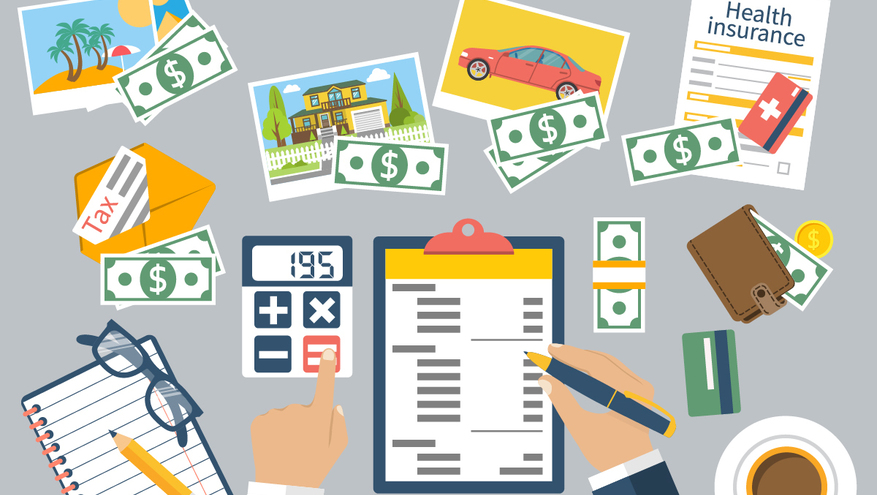 National
Standards for Personal Finance Education from the Council for Economic Education
and the Jump$tart Coalition (updated 2021) is "organized around six Topics, with Standards
and Learning Outcomes expected by the end of the 4th, 8th, and 12th grades."
The topics include earning income, spending, saving,
investing, managing credit, and managing risk. Per the
description:
National
Standards for Personal Finance Education from the Council for Economic Education
and the Jump$tart Coalition (updated 2021) is "organized around six Topics, with Standards
and Learning Outcomes expected by the end of the 4th, 8th, and 12th grades."
The topics include earning income, spending, saving,
investing, managing credit, and managing risk. Per the
description:
"Standards identify specific information that a student should understand at the completion of the given grade level. These Standards complete the phrase, “Students will know that...”
Each Standard includes two to four measurable Learning Outcomes, representing ways that students can demonstrate mastery of the Standard, including comprehension of the content as well as application to financial decision making. These Learning Outcomes complete the phrase, “Students will use this knowledge to...” " (p. 5).
From their literature review on financial literacy, Kasman, Heuberger, and Hammond (2018) of The Brookings Institution observed "there are overall low levels of financial literacy among American youth, with large numbers of students unprepared to navigate the many financial decisions that they will encounter during their lifetimes; this has serious, deleterious consequences for individuals, and implications for the U.S. economy" (p. 1). Unfortunately, K-12 public schools typically don't address financial literacy until the end of grade 11 or grade 12. In their Recommendations for Improving Youth Financial Literacy, they noted "Early, formal financial education can be “preventative,” acting as a barrier against and corrective for detrimental misconceptions and habits before an individual is faced with substantive financial decisions" (p. 2). Their research confirms that it's never too early to start teaching kids about finances and money management. Parents are often the first ones to begin this process.
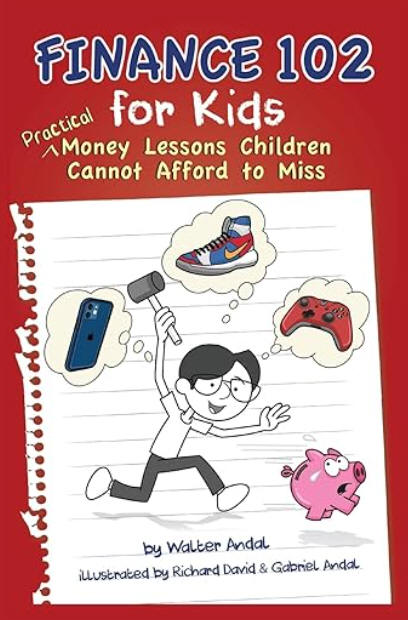
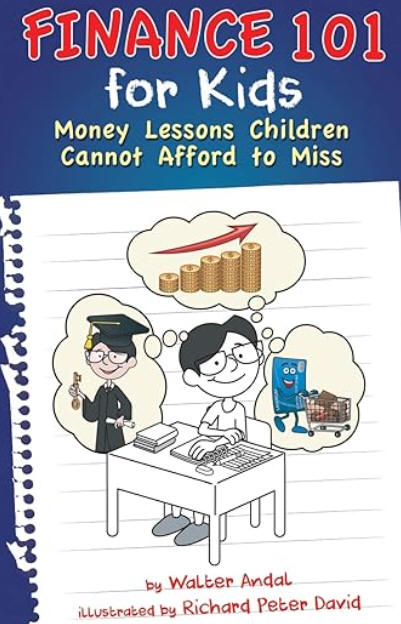 Walter Andal (2016) does this, too, in
Finance
101 for Kids: Money Lessons Children Cannot Afford to Miss. While meant for
middle school learners, anyone can benefit from this informative
and entertaining book. In ten chapters, he explains what finance is, how
money began, how to earn money, the power of money, credit and how to deal with
it, how to save money. He relates money to our economy introducing
supply/demand, inflation, unemployment, the stock market, and money around the
world. He concludes with his perspective of sharing money with the
community (e.g., donations to charities).
Walter Andal (2016) does this, too, in
Finance
101 for Kids: Money Lessons Children Cannot Afford to Miss. While meant for
middle school learners, anyone can benefit from this informative
and entertaining book. In ten chapters, he explains what finance is, how
money began, how to earn money, the power of money, credit and how to deal with
it, how to save money. He relates money to our economy introducing
supply/demand, inflation, unemployment, the stock market, and money around the
world. He concludes with his perspective of sharing money with the
community (e.g., donations to charities).
In his 2021 book, Finance 102 for Kids: Practical Money Lessons Children Cannot Afford to Miss, Walter Andal provides 30 lessons that address spending, cost and price, stretching your money's worth, media and social influence, credit cards, saving and investing, protecting your money, property, and reputation; and money and life principles.
ABCya: Learn to Count Money is an interactive game among several offered for preK-5 learners. Per its description at the site: "Children practice counting money by clicking and dragging bills and coins into a box. A correct answer earns a fish for the fish bowl. The activity progressively becomes more difficult as children progress. There are two levels: Beginner & Expert. Beginner allows students to count money using any amount of coins and bills. Expert requires students to use the least amount of coins and bills."
Biz Kid$ "is a national financial literacy initiative based on the Emmy Award-winning public television series where kids teach kids about money and business." You'll find the video episodes by season with their descriptions, lesson plans for middle and high school, an online course, and engaging games on business. The lesson plans are based on national standards for financial literacy and entrepreneurship education.
BrainPop: Financial Literacy addresses 13 topics appropriate for grades 3-8+.
Cha-Ching Money Smart Kids is a free program, which "aims to empower youth across the country with critical 21st century skills by beginning high-quality financial literacy education in elementary school." K-6 students will benefit from four storylines and the Cha-Ching band in 18 engaging episodes: Earn, Spend, Save, Donate. Each video also includes a classroom activity. There is also a contest. This resource was developed in partnership by Discovery Education and the Jackson Charitable Foundation.
HOT!: Crash Course Statistics is series of videos posted on YouTube that takes a closer look at how statistics play a significant role in everyday life "from batting averages and insurance rates to weather forecasting and smart assistants" and more. The first of those was posted in January 2018. You'll find episodes involving topics such as mathematical thinking, measures of central tendency and spread, data visualization, correlation, controlled experiments, sampling methods and bias in surveys.
Everfi K-12 Financial Education Courses for Kids provide virtual interactive learning experiences in game-based envionments. Courses are designated by grade level and are free. For example, one high school course delves into topics such as managing personal finances in the real world, applying for financial aid, establishing credit and investing. Another for grades 9-12 introduces the basics of investing. Middle school learners can take on a role of mayor of a town to help its citizens with their financial problems. There's a course for grades 7-10 in which students start a food truck business to learn what it means to be an entrepreneur. Students in grades 4-6 explore a virtual world to learn about the ins-and-outs of finances and the difference between needs and wants. Courses are aligned to standards, enable progress tracking, and are scenario-based to put learning in context.
FDIC: Teacher Online Resource Center provides "tools to help you teach financial education including lesson plans, videos, and other resources." You'll also find sections called Money Smart for Young People and a Youth Banking Resource Center. Per the site, the "Federal Deposit Insurance Corporation (FDIC) and the Consumer Financial Protection Bureau (CFPB) are working together to make it easier for schools to bring financial education into the classroom by developing a one-stop-shop for educators."
Financial Fables from the Federal Reserve Bank of Kansas City "are entertaining stories that combine reading, economics and personal finance into life lessons that feature "money morals." Through quick, interactive online tales, students can learn useful financial management skills that will better prepare them for the future. Created for students ranging from preschool to fifth grade, Financial Fables teach students about savings, money management, and how to set short- and long-term financial goals. Each fable is designed around the concept that it’s never too early to start learning about financial responsibility." (Website description)
Financial Football developed by Visa is a sports-themed game that helps students to learn about money management: saving and spending, budgeting, and wise use of credit. Players move down the football field to score touchdowns by answering multiple choice questions. For use in the classroom, each module comes with an overview of the concept, goals and objectives, teacher notes, discussion, and the activity questions. There are three levels of difficulty, available in English and Spanish. The game is primarily for ages 11 and up. For those who prefer soccer, there is also a Financial Soccer game on the same topics.
Financial Life Cycle Education Corp. (FiCycle) provides a project-based curriculum, which helps high school students to "acquire the algebra, probability, and statistics skills needed to make sound decisions at every stage of their financial life cycle" (Home page description). The course is aligned to Common Core math standards and Jump Start standards for personal finance, which are listed. Five units with the associated math address financial statements, earning interest, regular payments, insurance and expected value, and stocks and risk. There are also three additional alternative units. Teachers have access to free lessons covering topics ranging from stock market trends to the difference between wealth and cash.
Handbook of Essential Mathematics is from the Air Force Research Laboratory (2006) at Wright Patterson Air Force Base in Dayton, Ohio. It's a resource developed as part of their K-12 math, science, and technology outreach program. This open source online textbook with three sections is "a compendium of mathematical formulas and other useful technical information that will well serve both students and teachers alike from early grades through early college" (p. 3). It is included in this Math in Everyday Life section because "Section III, “Applications in Personal Finance”, is a small textbook within [this] book where the language of algebra is applied to that everyday financial world affecting all of us throughout our lives from birth to death" (p. 4).
Hands on Banking, provided by Wells Fargo, contains free financial curriculum designed for four age groups: kids in grades 4-5, teens in grades 6-8, young adults ages 15-21, and adults. Engaging self-paced online courses include instructional guides with lessons and classroom activities. Students gain real-world skills in money management.
IRS Understanding Taxes Simulations--"Apply what you've learned by putting yourself in the shoes of 20 different taxpayers while you explore the ins and outs of filing tax returns electronically!" Students and any taxpayer will benefit from these simulations. You'll also find tax tutorials and a series of assessments to test your understanding. The IRS also has classroom lesson plans in its Understanding Taxes Teacher Site.
Kids' Money is "an interactive resource for parents, teachers, teens, kids, organizations and international visitors designed to help children develop successful money management habits and become financially responsible adults" per the site's description. Teachers will find financial principles and lesson plans listed by grade level preK-12. Sections include topics in saving, spending, earning, sharing, allowances. Age appropriate books, news, and a financial terms glossary are among other resources.
Math and Money for Kids is a collection of over 100 games, activities, audiobooks and more gathered by CreditDonkey. Of values is that resources are grouped into categories: How Money Works, Counting Money, Earning Allowances; Buying, Selling, and Borrowing; Saving Money and Why It's Important, Financial Literacy for Kids, and Advanced Concepts: Investing and Checks.
Math Interactives is part of LearnAlberta.ca. "This multimedia resource includes interactive math activities, print activities, learning strategies, and videos that illustrate how math is used in everyday life. The resource addresses the following mathematics topics: Fractions; Integers; Percentages; Rate/Ratio/Proportion; Square Roots; Exponents; Patterns; Algebra; Linear Equations; Polynomials; Angles; Circles; Surface Area and Volume; Area and Perimeter; Triangles; Pythagoras; Trigonometry; Similarity and Congruence; Transformations; Shape Classification; Data Display and Graphs; Central Tendency and Distribution; and Probability." (Math Interactives Home page section).
Math Matters, Apply It! SIAM, the Society for Industrial and Applied Mathematics, developed this series of pdf documents to increase awareness of applied mathematics. SIAM indicated these were "created for anyone who wants to know more about the mathematics behind everyday life and the technologies we encounter." You will learn about the math behind renewable wind energy, immunology, vaccination, earthquake simulations, x-ray crystallography, sand and dune motion, image compression, statistics in sports, supercomputing, speeding up the internet, cardiology and heart attacks, stopping and preventing fires, digital face recognition, digital animation, using DNA, CDs and anti-skip technology, with more to come. Each is one page and can be used with elementary, middle, and high school learners.
Math Munch aims to help "kids find something mathematical that they love." It's tagline is "A Weekly Digest of the Mathematical Internet." In weekly posts, the developers "share stories about ordinary people who have extraordinary passions for mathematics. [They] share resources that students can use to create math of their own. Perhaps most importantly, [they] share and model an excitement for exploring mathematics and learning new things." And they "use language and examples that are accessible to students at least as young as fifth grade, and probably younger" (Why Math Munch? section). You'll also find math games, math art tools, videos, software, and some thoughts for teachers.
Mathigon: Applications of Mathematics help to "Learn about the countless hidden applications which mathematics has in everyday life: from computers to weather prediction, video games, medicine, sports and music. Explore by industry or subject topic. Each activity includes additional resources to learn more.
Money Math: Lessons for Life from the U.S. Department of the Treasury is a four-lesson curriculum supplement designed for students, grades 7-9, who will learn math concepts using real-life examples from personal finance. The free downloadable book features a teacher's guide with lesson plans, reproducible activity pages, and teaching tips. Lessons are titled: The Secret to Becoming a Millionaire, Wallpaper, Math & Taxes, and Spreading the Budget. Highly recommended.
Next Gen Personal Finance is a free personal finance curriculum and professional development partner helping teachers deliver essential money understanding with an emphasis on real-world applications. Curriculum options include nine-week, semester, and year long courses that are appropriate for learners in middle school and high school. There are 12 units featuring "Investing, Taxes, Saving, Behavioral Economics, and Paying for College" (About Us section). There is also a free Fnancial Algebra Course for grades 9-12 with 10 units, each of which "blends one core personal finance topic with one relevant math concept (e.g. Investing and Exponential Functions)." Curriculum also includes a collection of math activities with real-world personal finance application problems.
 NRICH
from the University of Cambridge is devoted to enriching mathematics for
learners in grades 1-12 with games, problems, investigations, articles and books.
Resources are free. This project is part of the the
Millennium Mathematics Project, a long-term
national math education initiative in the UK for ages 3-19 and the general
public. See also the Plus site, which is their internet magazine with articles, podcasts, news, a
blog, puzzles, careers in math, and more.
Plus aims to introduce readers to the beauty and the practical
applications of mathematics in science, art and society. The Plus Careers
with Math section contains a library of interviews that explore the careers of
people who use math in their jobs every day.
NRICH
from the University of Cambridge is devoted to enriching mathematics for
learners in grades 1-12 with games, problems, investigations, articles and books.
Resources are free. This project is part of the the
Millennium Mathematics Project, a long-term
national math education initiative in the UK for ages 3-19 and the general
public. See also the Plus site, which is their internet magazine with articles, podcasts, news, a
blog, puzzles, careers in math, and more.
Plus aims to introduce readers to the beauty and the practical
applications of mathematics in science, art and society. The Plus Careers
with Math section contains a library of interviews that explore the careers of
people who use math in their jobs every day.
Pathway to Financial Success in Schools from Discover Financial Services and Discovery Education includes comprehensive financial literacy resources for middle and high school learners. Educators, students and families will appreciate the standards aligned lessons, guides and videos, self-paced modules, and family activities.
PBS Learning Media: Cyberchase: Per its description, Cyberchase is "an Emmy award-winning animated math mystery show featuring a team of curious kids who use their math and problem solving skills to outwit and outsmart the villain Hacker in their quest to save Cyberspace. In addition to segments from the animated portion of the show, this collection of resources includes live-action For Real segments, in which hosts Bianca and Harry explore the show's math topics in everyday life." You'll find videos on algebra, geometry, data analysis and measurement, numbers and operations, math and health, math and the environment, and more.
PBS NOVA Labs: Financial Lab is a free game-based resource "designed to help students (and adults!) understand how we humans make financial decisions, and how to develop habits to overcome the behavioral biases that often get in our way. Think of it as a fun, safe place to practice managing your spending, paying off debts, and investing in your future" (About section). There are three mini-games: Shopportunity Cost, Budget Buster, and Exponential Potential. An educator guide is provided. Other NOVA Labs with games in each are available, which teach students age 6 and up a range of STEM subjects.
Practical Money Skills: Visa partnered with leading consumer advocates, educators, and financial institutions to create the Practical Money Skills program so that students of all ages can learn the basics of personal finance. These free educational resources include personal finance articles, games, lesson plans linked to standards, and more. Online multimedia games include such titles as Financial Football, Financial Soccer, Smart Money Quiz Show, Roadtrip to Savings, Ed's Bank, and more. You'll also find financial lesson plans for special needs learners.
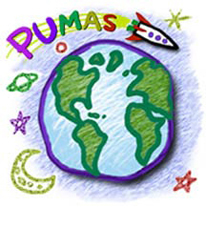 PUMAS:
Practical Uses of Math and Science, is an online journal for pre-college
education with "brief examples showing how math and science topics taught in
K-12 classes can be used in interesting settings, including every day life."
It is aimed primarily at classroom teachers for use with their learners.
Examples are available for grades K-2, 3-5, 6-8, and 9-12.
PUMAS:
Practical Uses of Math and Science, is an online journal for pre-college
education with "brief examples showing how math and science topics taught in
K-12 classes can be used in interesting settings, including every day life."
It is aimed primarily at classroom teachers for use with their learners.
Examples are available for grades K-2, 3-5, 6-8, and 9-12.
Statistics in Schools from the U.S. Census Bureau helps to educate K-12 students about the value and use of statistics in everyday life. The program provides resources for teaching and learning with real life data. Common Core standards-aligned, classroom-ready activities in math and history, data visualizations and more are included. Activities are available by grade band with an approximate time for completion of each. Teacher and student versions are provided. This is an excellent resource.
Stukent: Mimic Personal Finance Simulation for high school "lets students practice decision-based learning, make real-world financial choices, go beyond theory, and experience in-class consequences." Students learn about banking, assets and liability, income growth, make financial decisions on unexpected events, and apply budgeting skills in a section called "buying grades." Lecture videos are included, as well as a curriculum and in-class activities to help teaching. You can request a quote.
TeachEngineering provides a free digital library with "teacher-tested, standards-based engineering content for K-12 teachers to use in science and math classrooms. Engineering lessons connect real-world experiences with curricular content already taught in K-12 classrooms. ... curricula are hands-on ... and relevant to children's daily lives" (Home Page Welcome). The site is "a collaborative project between faculty, students and teachers associated with five universities and the American Society for Engineering Education, with NSF National Science Digital Library funding" (About section). Highly recommended.
TeachFinLit.org contains resources for high school educators to teach financial literacy concepts. Topics include income and careers, budgeting and spending, credit and debt, saving and investing, risk management and insurance, and key concepts. The site is comprehensive and also includes a full curriculum for new teachers.
Teaching Children About Money: Resources for Promoting Financial Literacy by Age from FiscalTiger include age-appropriate activities and apps. Resources are grouped for toddlers, and elementary, middle, and high school.
TV411 from the Education Development Center has a series of videos and web lessons involving math skills used in everyday life and in some careers. They are organized by basic math; ratios, averages, and exponents; fractions, decimals and percents; and geometry. For example, learn about area and tiling the New York subway, carpenter math, estimating pricing a painting job, reading a graph on a utility bill, ratios in the kitchen, finding the best cell phone plan, planning a trip using a map to figure time and distance, selecting the best unit price when shopping, using football, basketball, music and dance as explained by pros to learn about percentages, decimals, and probability, and fractions; using origami to learn some geometry, and more.
The U.S. Currency Education Program will help everyone learn about the seven denominations of U.S. currency issued by the Federal Reserve Board ($1, $2, $5, $10, $20, $50, $100), their design and security features, and life cycle. The site also offers videos to learn more, and a history of U.S. currency.
Lavamind.com has simulations (e.g., Gazillionaire, Zapitalism, & Profitania), each with a higher level in building proficiency with business, math, and economics principles. A free demo version of Gazillionaire, Zapitalism, and Profitania is available. Gazillionaire, for example, is a “cross between Monopoly set in outer space and Wall Street in wonderland” with real-world economic tools to “help you determine where supply meets demand as you race to build your trade empire. Six people can play at a time on the same computer or by email over the Internet. The first company to reach a net worth of a billion kubars wins!” Also see Biztopia, a mobile business simulation game for iOS and Android.
Lemonade Stand: Open your own lemonade stand and run a business for 7, 14, or 30 days. Make all your own decisions on pricing, inventory, quality, and purchasing supplies and see how much money you can make. Of course you'll be influenced by the weather.
The Stock Market Game offers a library of learning materials correlated to national voluntary educational standards in math, business education, and economics. This resource has been used at all levels, from fourth grade to college, all across the curriculum. Starting with a virtual cash account of $100,000, students strive to create the best-performing portfolio using a live trading simulation. The program also reinforces critical thinking, decision-making, cooperation and communication skills, independent research. Students use real Internet research and news updates, making the simulation an even better mirror of the real marketplace.
How the Market Works is a free simulation game designed to help beginners to understand how the stock market and stock trading works by practicing trading. After registering, you receive a brokerage account with a virtual $25,000 in cash and you are able to begin practice trading right away. The stock simulator performs like a real brokerage account. To help you get started, there is an Education Center with numerous articles, videos and tutorials, including a teacher guide among the list of Teacher Tools. This program can be used with middle school learners and above.
Venture Valley Business Simulation Game is free from the Singleton Foundation for Financial Literacy and Entrepreneurship. It can be played alone or with others on your mobile device (iOS and Android) or PC (via Steam). "Build your empire from scratch, starting with a dog walking business. Then flip that into a successful mini-golf course, pizza parlor, drone delivery servi.ce, robot factory, or any other thrilling company available in Venture Valley."
Virtual Business Simulations are an engaging way to help high school students "learn key business, marketing, and personal financial concepts including accounting, marketing, management, entrepreneurship, sports marketing and management, financial literacy, hospitality, and more."
Wall Street Survivor is a free stock market simulator. You can learn about investing and personal finance with free courses. Practice trading and build a portfolio with a virtual $100,000. Registration is free and after you register you can also enter monthly contests and win prizes.
HOT! TED-Ed Lessons Worth Sharing includes a series of videos on Math in Real Life. Educators can use them or select a YouTube video to then create a lesson. You can add multiple choice and open-ended questions, discussion prompts, and additional resources. Share the lesson with students and track their progress. Sample lessons are also available.
 On March
13, 2010, the Obama administration released its
blueprint for revising the Elementary and Secondary Education Act
(ESEA). One of those proposals calls for a complete and well-rounded education
with support for "strong instructional practices in arts, foreign languages,
history and civics, financial literacy, environmental education, and other subjects" (p. 19). The research outlined in
the proposal for
A Complete Education (2010) noted:
On March
13, 2010, the Obama administration released its
blueprint for revising the Elementary and Secondary Education Act
(ESEA). One of those proposals calls for a complete and well-rounded education
with support for "strong instructional practices in arts, foreign languages,
history and civics, financial literacy, environmental education, and other subjects" (p. 19). The research outlined in
the proposal for
A Complete Education (2010) noted:
One strategy for ensuring a well-rounded education is the integration of instruction in English-language arts and mathematics with other subject areas that are not currently covered by accountability testing, particularly social studies and the arts (Gunzenhauser, 2003; Manzo, 2005; Meyer, 2005; Pinzur, 2004; Rabkin and Redmond, 2005; Vogler, 2003; von Zastrow and Janc, 2004). In this approach, content from science, social studies, foreign languages, or the arts is used during the instruction of mathematics, reading, or writing. (p. 19)
Hence, readers will note that the resources that follow would support this proposal.
Artful Maths includes mathematical art lessons, classroom display ideas, origami in lessons and an origami gallery to inspire, and a blog. Of interest are the variety of images of insects shown in the blog to illustrate math features (e.g., symmetry, hexagons) and the beauty of nature. This site is definitely worth viewing.
Masterpieces to Mathematics: Using Art to Teach Fraction, Decimal, and Percent Equivalents by Christopher Scaptura, Jennifer Suh, and Greg Mahaffey (2007, August) is a lesson, which appeared in Mathematics Teaching in the Middle School. "This article shares how students created their own OpArt (optical art) which was inspired by Ellsworth Kelly, and how they connected that work of art to rational numbers. By identifying colored portions on a grid, the students recognized fraction, decimal, and percent breakdowns of their own designs" (p. 24).
Mathematics and Art was the 2003 theme for the Mathematics Awareness Month, which is sponsored each year in April by the Joint Policy Board of Mathematics. Joseph Malkevitch (York College, CUNY) gathered resources to explore this relationship. He stated, "There are, in fact, many arts (music, dance, painting, architecture, sculpture, etc.) and there is a surprisingly rich association between mathematics and each of the arts. My goal here is to give some pointers concerning these many connections" (Introduction section). You'll learn about mathematical tools for artists, symmetry, mathematical artists and artist mathematicians; polyhedra, tilings, and dissections; origami (the art of paper folding), and more. For more information, see themes for the Mathematics and Statistics Awareness Month. The Joint Policy Board of Mathematics is a collaborative effort of the American Mathematical Society, the American Statistical Association, the Mathematical Association of America, and the Society for Industrial and Applied Mathematics.
Mathematical Imagery from the American Mathematical Society further explores the relationship between mathematics and art. The collection of albums of math imagery is extensive from snowflakes, fractals, quilts, woven beads to origami, computer-generated landscapes, tessellations, geometric sculptures, and more.
National Gallery of Art has online interactive classroom lesson units connecting art to curriculum. In Counting on Art, elementary and middle school learners "explore the paintings of Horace Pippin and Wayne Thiebaud and the mobiles of Alexander Calder to discover and practice math and visual art concepts." In New Angles on Art, middle and high school learners focus on two artists and an architect. "The interactive lessons focus on the math—lines, angles, two-dimensional shapes and three-dimensional polyhedra, fractions, ratios, and permutations—found in sculptures in the National Gallery Sculpture Garden and in the architecture of the East Building."
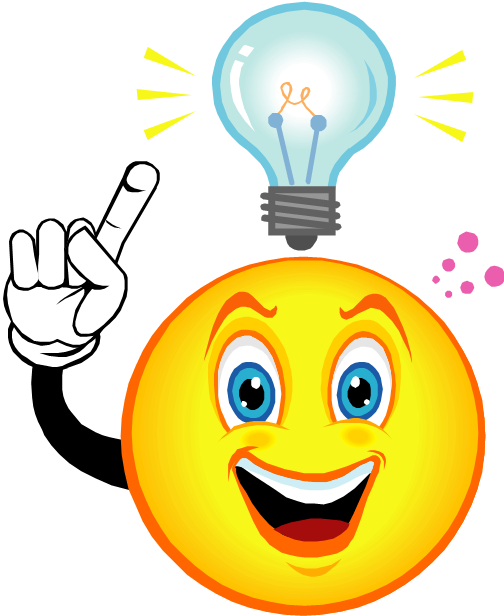
Use Desmos to have learners connect math to art. Create equations associated with your drawing, add color and so on. Art can range from simple to complex, depending on your math skills.
See the many image examples on the web with a search phrase such as "demos art with equations."
Get some how-to's with the following:
Desmos Art Tutorials on YouTube.
Desmos Art: The Definitive Guide to Computational Sketching at Math Vault.
Mathematics and Geography from TeacherVision. You'll find printables, lessons, and activities for K-12 that connect math and geography. For example, use these resources to teach students how to read a map and navigate with mathematical instruments. You'll find lesson plans to help students learn how to make a budget for trip expenses and how to interpret U.S. Census data. There are also handouts on weather, elevation, and converting measurements of distance.
Math and Children's Literature from Carol Hurst's Children's Literature Site contains a list of books, sample chapters, and articles with strong math themes.
Math and Literature Idea Bank. This resource is primarily for elementary grades brought to you by MathCats. Suggested books and how to use them to connect math to literature are presented.
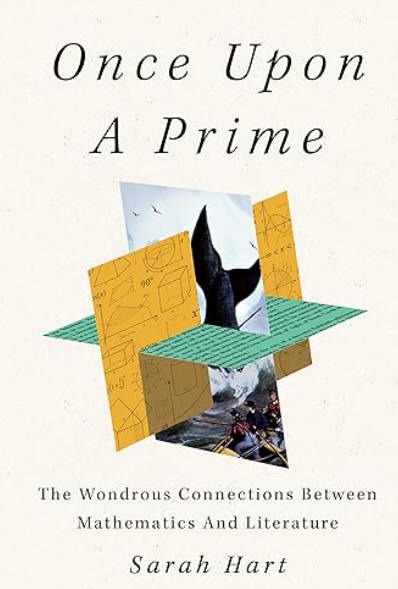 Once Upon A Prime: The Wondrous
Connections Between Mathematics and Literature is a 2023 book by Sarah Hart.
From children's rhymes, fairy tales, folklore, and poetry to novels like Moby Dick,
Jurassic Park, The Luminaries, War and Peace, and Gulliver's Travels,
Hart delves into the connections between math and literature. You'll be
surprised at how easy it is to follow her presentation.
Once Upon A Prime: The Wondrous
Connections Between Mathematics and Literature is a 2023 book by Sarah Hart.
From children's rhymes, fairy tales, folklore, and poetry to novels like Moby Dick,
Jurassic Park, The Luminaries, War and Peace, and Gulliver's Travels,
Hart delves into the connections between math and literature. You'll be
surprised at how easy it is to follow her presentation.
HOT!: Mathematics & Music from the American Mathematical Society provides videos, podcasts, and articles to show the connections between mathematics and music. Per the AMS: "Counting, rhythm, scales, intervals, patterns, symbols, harmonies, time signatures, overtones, tone, pitch" are connected to mathematics.
Where Math Meets Music by Joseph Heimiller takes a look at such things as frequency and sound waves created by musical instruments. Site might be more appropriate for high school learners and above.
Simplifying Theory delves into how mathematics is related to music--a very interesting read supported by images.
Motivate Cross-Curricular Maths Resources is part of the family of activities in the Millenium Mathematics Project from the University of Cambridge. Math activities link to art and design, citizenship/PSHE, design and technology, economics, geography, history, media studies, music, science, sport. This is truly a valuable resource.
Radical Math is for educators interested in integrating issues of social and economic justice into their math classes and curriculum. You'll find links to access and over 700 lesson plans, articles, graphs, charts, data sets, maps, books, and websites to bring these issues into the classroom.
Yummy Math helps teachers bring real-life into math classrooms for learners in grades 3-8 and high school. You'll find activities that correspond to the NCTM Process Standards and the CCSS Standards for Mathematical Practice, easily found by strand within a grade or genre (e.g., math and food, math and science, math and art, math and social studies, math and entertainment, sports).
According to Kyeong Ha Roh (2003):
Problem-Based Learning (PBL) describes a learning environment where problems drive the learning. That is, learning begins with a problem to be solved, and the problem is posed is such a way that students need to gain new knowledge before they can solve the problem. Rather than seeking a single correct answer, students interpret the problem, gather needed information, identify possible solutions, evaluate options, and present conclusions. Proponents of mathematical problem solving insist that students become good problem solvers by learning mathematical knowledge heuristically. (Roh, 2003, para. 1)
One way to help learners become better problem solvers, according to Cathy Seeley (2017), is to use an "upside-down teaching" model, which involves productive struggle. In a traditional teaching model, the teacher would explain a procedure or concept, the class would work examples together, and then learners would apply what they just learned to solve a word problem. But in the upside-down model, learners are presented a problem that they might not know how to solve, then there is discussion on their thinking and their work to solve it. The teacher's role is to "help connect class discussion to the goal of the lesson" (Seeley's Figure 1).
Paul Zeitz (2007) distinguishes between exercises and problems:
An exercise is a question that tests the student's mastery of a narrowly focused technique, usually one that was recently "covered." Exercises may be hard or easy, but they are never puzzling, for it is always immediately clear how to proceed. Getting the solution may involve hairy technical work, but the path towards solution is always apparent. In contrast, a problem is a question that cannot be answered immediately. Problems are often open-ended, paradoxical, and sometimes unsolvable, and require investigation before one can come close to a solution. Problems and problem solving are at the heart of mathematics. Research mathematicians do nothing but open-ended problem solving. In industry, being able to solve a poorly defined problem is much more important to an employer than being able to, say, invert a matrix. A computer can do the latter, but not the former. (Zeitz, 2007, p. x)
Thus, problem-based learning is not the same as solving the exercises that follow sections in math textbooks. Per David Moursund (2016), "A section in a chapter discusses a quite specific problem-solving topic and gives examples of how to solve that type of problem. Then students are asked to practice solving that type of problem over and over again" (Math Problems versus Math Exercises section).
Moursund (2016) included several possible characteristics of a good problem for a problem-based learning assignment. In his words:
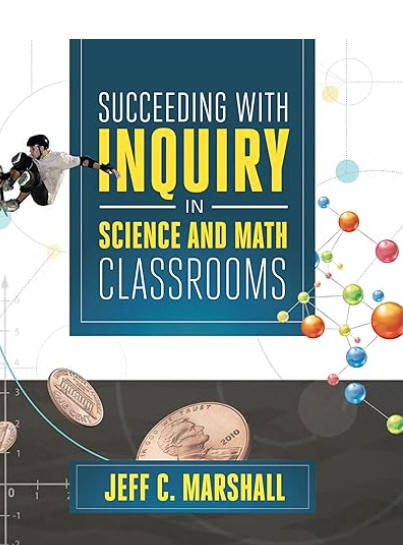 Succeeding
with Inquiry in Science and Math Classrooms
by Jeff Marshall (2013) includes the need for inquiry in your classroom,
details of inquiry instruction (e.g., the framework, exemplars,
how inquiry appears in units of study), and advice on how to be
successful with this method. Real-world lesson plans are provided
to illustrate effective inquiry-based instruction.
Succeeding
with Inquiry in Science and Math Classrooms
by Jeff Marshall (2013) includes the need for inquiry in your classroom,
details of inquiry instruction (e.g., the framework, exemplars,
how inquiry appears in units of study), and advice on how to be
successful with this method. Real-world lesson plans are provided
to illustrate effective inquiry-based instruction.
emergent math is a blog that has some great ideas for introducing students to inquiry-based learning. Begin your exploration with A Problem Based Learning Starter Kit, posted October 30, 2013. You will also find a set of Common Core Problem Based Curriculum Maps for grades 3-11, algebra 1, geometry, and algebra 2.
Origami, the art of folding two-dimensional paper into three-dimensional objects, can be seen throughout the world. YouTube has several videos illustrating the value of this art. For example, view 11 Levels of Origami: Easy to Complex as explained by origami artist and physicist Robert Lang. Also of interest is How NASA Engineers Use Origami To Design Future Spacecraft.
Get some classroom ideas for using origami at the Origami Resource Center/. It's easy to connect origami to math and geometry, in particular.
Mathigon: Mathematical Origami includes colorful examples of the Platonic Solids, Archimedean Solids, Stars and Compounds, and Beautiful Origami. Many come with folding instructions and associated net.
There are many ways to solve problems. View the Problem-Solving Strategies Mindmap at GoGeometry.com
John Malouff grouped and explained over 50 problem-solving strategies-2022, many of which can be applied to mathematics problem solving.
George Polya's Problem-Solving Techniques contain details of his four principles that have become a classic for math problem-solving: understand the problem, devise a plan, carry out the plan, and look back.
Closely connected to Polya's techniques for problem-solving, Douglas Fisher and Nancy Frey (2023) suggested when solving a mathematical word problem that learners read the problem three times. "On the first reading, students focus on locating what is being asked. During the second reading, they attend to the mathematical terms used to understand the necessary computations. On the third read, the group makes a plan to solve the problem and then executes the plan." (Disciplinary Literacy in Mathematics section)
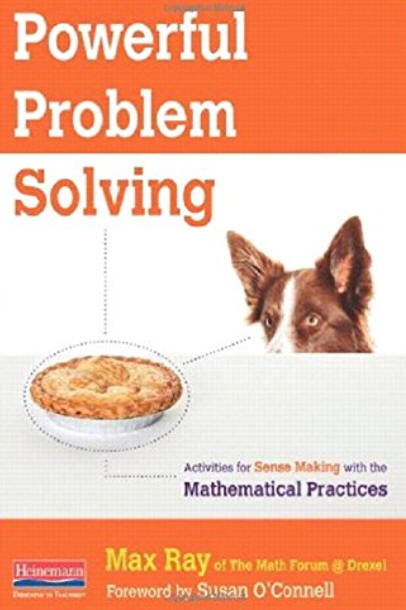 Powerful
Problem Solving: Activities for Sense Making with the Mathematical Practices
is by Max Ray and colleagues (2013) of the Math Forum at Drexel University.
The authors provide advice and activities that teachers can use to help students
become proficient problem solvers in keeping with the Common Core standards
for mathematical practices.
Powerful
Problem Solving: Activities for Sense Making with the Mathematical Practices
is by Max Ray and colleagues (2013) of the Math Forum at Drexel University.
The authors provide advice and activities that teachers can use to help students
become proficient problem solvers in keeping with the Common Core standards
for mathematical practices.
See the following practice guide:
Woodward, J., Beckmann, S., Driscoll, M., Franke, M., Herzig, P., Jitendra, A., Koedinger, K. R., & Ogbuehi, P. (2012, revised October 2018). Improving mathematical problem solving in grades 4 through 8: A practice guide (NCEE 2012-4055). Washington, DC: National Center for Education Evaluation and Regional Assistance, Institute of Education Sciences, U.S. Department of Education. https://ies.ed.gov/ncee/wwc/Docs/PracticeGuide/MPS_PG_043012.pdf
Woodward and colleagues provided five "recommendations for improving mathematical problem-solving skills, regardless of which curriculum is used. ... . [The guide] presents evidence-based suggestions for putting each recommendation into practice and describes roadblocks that may be encountered, as well as possible solutions." (p. 6)
They elaborated on the recommendations, which include:
 In
their 2013 study, Kara Jackson, Anne Garrison, Jonee Wilson, Lynsey
Gibbons and Emily Shahan noted four key elements of an effective set-up of a challenging math problem
or task:
In
their 2013 study, Kara Jackson, Anne Garrison, Jonee Wilson, Lynsey
Gibbons and Emily Shahan noted four key elements of an effective set-up of a challenging math problem
or task:
Certainly, results can apply to all math levels.
Reference:
Jackson, K., Garrison, A., Wilson, J., Gibbons, L., & Shahan, E. (2013). Exploring relationships between setting up complex tasks and opportunities to learn in concluding whole-class discussions in middle-grades mathematical instruction. Journal for Research in Mathematics Education, 44(3), 646-682. http://mathedseminar.pbworks.com/w/file/fetch/69060017/JReseMathEduc.44.4.0646.pdf
The pure mathematics we teach must be linked to real world applications, so that students do not have to ask: Where are we going to use this? In discussing the nature of mathematical modeling, Ang Keng Cheng (2001) noted:
"Mathematical modelling is a process of representing real world problems in mathematical terms in an attempt to find solutions to the problems. A mathematical model can be considered as a simplification or abstraction of a (complex) real world problem or situation into a mathematical form, thereby converting the real world problem into a mathematical problem. The mathematical problem can then be solved using whatever known techniques to obtain a mathematical solution. This solution is then interpreted and translated into real terms" (para. 7).
The steps in modeling may or may not be sequential:
Henry Pollack (Gould, Murray, Sanfratello, 2012) clarified for educators "how mathematical modeling differs from what you already teach, particularly, “problem solving”. Problem solving may not refer to the outside world at all. Even when it does, problem solving usually begins with the idealized real-world situation in mathematical terms, and ends with a mathematical result. Mathematical modeling, on the other hand, begins in the “unedited” real world, requires problem formulating before problem solving, and once the problem is solved, moves back into the real world where the results are considered in their original context" (p. viii).
Learn more about math modeling in Algebra 1 and its role in the curriculum via the Annenberg Learner: Mathematical Modeling.
HOT!: Consortium for Mathematics and Its Applications (COMAP, Inc.) and Society for Industrial and Applied Mathematics (SIAM) produced Guidelines for Assessment and Instruction in Mathematical Modeling Education, 2nd edition (GAIMME, 2019). It's opening section delves into "What is Mathematical Modeling?" Then the following sections include exemplary math modeling tasks for learners in grades preK-8, 9-12, and at-the undergraduate level. An "appendix contains examples of assessment tools, including checklists and rubrics that you might consider using when teaching with modeling" (p. 209).
MATHmodels.org has contests and problems on math modeling for high school and undergraduate learners. “Mathmodels is COMAP’s new modeling forum. On this site, students and faculty will find a wide range of interesting contemporary modeling problems. Teachers can assign problems. Students can choose to work on problems based on math topic and application area” (About MATHmodels section). Note: This site has particular relevance, as math modeling is among mathematical practices included in the Common Core State Standards for mathematics. Read about CCSS high school math modeling.
MathWorks Math Modeling Challenge (M3Challenge) is an applied mathematics competition for high school junior and senior students. Winners receive scholarships totaling thousands of dollars for continuing education. The contest is sponsored by MathWorks and SIAM (Society for Industrial and Applied Mathematics). Resources include math modeling handbooks, math modeling videos (including teaching math modeling), tips and guidelines for teaching math modeling, and sample problems.
Saltire Software developed Geometry Expressions and has provided GXWeb for free browser-based mathematical modeling.
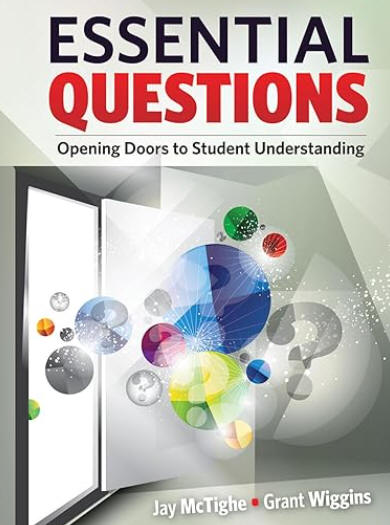 As you delve into math modeling and problem solving with your learners,
consider the following essential questions in mathematics, suggested by Jay
McTighe and Grant Wiggins (2013) in their book
Essential
Questions: Opening Doors to Student Understanding:
As you delve into math modeling and problem solving with your learners,
consider the following essential questions in mathematics, suggested by Jay
McTighe and Grant Wiggins (2013) in their book
Essential
Questions: Opening Doors to Student Understanding:
 Are you relying on the math problems that follow each section
in your textbook? If so, David Ginsburg (2016) suggested
that quality rather than quantity may better serve students when
it comes to practice. Here's his "four viable purposes for
assigning math problems to students" (para. 4):
Are you relying on the math problems that follow each section
in your textbook? If so, David Ginsburg (2016) suggested
that quality rather than quantity may better serve students when
it comes to practice. Here's his "four viable purposes for
assigning math problems to students" (para. 4):
Phillips Exeter Academy in New Hampshire is one example of a high school that takes a problem-based approach to teaching mathematics. Their math teaching materials include problem sets for its courses that drive learning. These latter are well-worth viewing as examples of problems that students are solving.
 Art
of Problem Solving (AoPS) creates educational materials for students in
grades 2-12. AoPS Online contains a variety of resources for students of mathematics in
grades 5-12, including textbooks, online courses, as well as full courses for
math contest preparation. AoPS Beast Academy is an advanced comic-based
math program for students in grades 2-5 designed to build problem-solving skills
for school and life. The Art of Problem Solving Foundation also administers the
USA Mathematical Talent Search (USAMTS)
website. The USAMTS is a free mathematics competition open to any US
middle or high school student. AoPS also has a set of problem solving
textbooks. The following are among those:
Art
of Problem Solving (AoPS) creates educational materials for students in
grades 2-12. AoPS Online contains a variety of resources for students of mathematics in
grades 5-12, including textbooks, online courses, as well as full courses for
math contest preparation. AoPS Beast Academy is an advanced comic-based
math program for students in grades 2-5 designed to build problem-solving skills
for school and life. The Art of Problem Solving Foundation also administers the
USA Mathematical Talent Search (USAMTS)
website. The USAMTS is a free mathematics competition open to any US
middle or high school student. AoPS also has a set of problem solving
textbooks. The following are among those:
|
The Art of Problem Solving, Vol. 1: The Basics (2011) is appropriate for students who are just beginning in math contests. It contains over 500 problems and exercises taken from past contests, such as MATHCOUNTS and others. "The emphasis on learning and understanding methods rather than memorizing formulas enables students to solve large classes of problems beyond those presented in the book." |
Competition Math for Middle School (2011) contains over 700 examples and problems in algebra, counting, probability, number theory, and geometry. Although written for exceptional students in middle school and teachers looking for challenging advanced math problems, this book could also be used by anyone interested in problems found in national math competitions. Solutions are included. |
A+Click allows students in grades 1-12 to solve challenging math and logic problems, practicing over 1000 math skills. "The problems include a short description and an illustration to help problem solvers visualize the model. The problems can be solved within one minute and without a calculator. The tests adapt to student ability. To progress to a higher level, you must correctly answer five consecutive questions. The tests concentrate on understanding, spatial reasoning, and problem solving rather than math rules and theorems." Questions are based on Common Core math standards. (About section)
Advanced Common Core Math Explorations (ACCME) is a series of six books (2014-2017) for grades 5-8 by Jerry Burkhart of 5280 Math. Per their descriptions, each book presents learners "challenging activities that deepen and extend their understanding of concepts from the Common Core State Standards for Mathematics. ... Each activity comes with extensive support for teachers including learning goals, discussion guides, detailed solutions, and suggestions for extending the investigations." The beauty of these activities, designed for upper-elementary and middle school, is their open-ended nature. Each book is devoted to a specific topic (the first is shown), which Burkhart describes as follows:
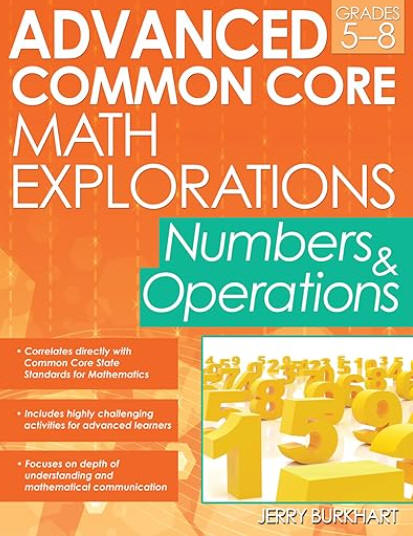 ACCME: Numbers and Operations
(2014). Learners "investigate numeration systems of beings from another planet, create and solve
stories and problems with extreme numbers, use place value to design
their own divisibility tests, and play with a magical number line that
multiplies numbers without a calculator."
ACCME: Numbers and Operations
(2014). Learners "investigate numeration systems of beings from another planet, create and solve
stories and problems with extreme numbers, use place value to design
their own divisibility tests, and play with a magical number line that
multiplies numbers without a calculator."Citizen Math (formerly Mathalicious) provides supplementary math lessons for grades 6-12, which you can filter by grades 6, 7, 8 and algebra 1, algebra 2. Lessons relate to real world scenarios and include the standards addressed, lesson guide, student handout, and multimedia presentation. Lessons ask real open-ended questions requiring students to make sense of problems and to develop their own strategies for solving them. Students must support and justify their own methods and conclusions, and evaluate the validity of others’ arguments. Lessons prompt students to model their findings in a variety of ways: numerically, graphically, algebraically and verbally. While not free, Citizen Math does provide a sample of free complete lessons to introduce you to this resource.
K-12 Math Problems by Erlina Ronda is written for students. You'll find problems, solutions, explanations, and common errors. Problems are categorized into middle school, algebra, geometry, trigonometry, combinatorics, probability, numbers, ratio and proportion, puzzles, and calculus.
Math and Logic Problems Galore is actually a collection of links to sites with puzzles, math problems, games, logic brain teasers, and more and is well worth a look. The collection is grouped: Everyday math and logic problems for everyone; math and logic for kids, then teenagers, then mathematicians and logicians. These are educational in nature and can be used in school settings.
 Math.com: The World of Math Online is
dedicated to solving math problems at nearly every level of school
mathematics, including basic math, algebra, geometry, trigonometry,
statistics, calculus and more. There are online math tools:
calculators, graphing utilities, test preparation and study tips, free
homework help, a glossary and a math library. Teacher and parent
resources are extensive.
Math.com: The World of Math Online is
dedicated to solving math problems at nearly every level of school
mathematics, including basic math, algebra, geometry, trigonometry,
statistics, calculus and more. There are online math tools:
calculators, graphing utilities, test preparation and study tips, free
homework help, a glossary and a math library. Teacher and parent
resources are extensive.
 MathPickle
"is a free online resource of original mathematical puzzles, games and unsolved
problems for K-12 teachers. It is supported by the American Institute of
Mathematics. ... Puzzles are organized by grade and subject -- each designed for
a 45-60 minute period" (About Us section).
MathPickle
"is a free online resource of original mathematical puzzles, games and unsolved
problems for K-12 teachers. It is supported by the American Institute of
Mathematics. ... Puzzles are organized by grade and subject -- each designed for
a 45-60 minute period" (About Us section).
MIT BLOSSOMS features a video library with over 100 free math and science lessons primarily for high school students. "Every lesson is a complete resource that includes video segments, a teacher’s guide, downloadable hand-outs and a list of additional online resources relevant to the topic. Each 50-minute lesson builds on math and science fundamentals by relating abstract concepts to the real world. The lessons intersperse video instruction with planned exercises that engage students in problem solving and critical thinking" (About Us section). This site is an initiative of MIT's Learning International Networks Consortium. All lessons are mapped to both the Common Core State Standards and the Next Generation Science Standards.
HOT!: Open Middle for K-12 math, including calculus, contains problems that help learners to develop critical thinking. They have a "closed" beginning, a "closed" end, but as the title suggests, there is an "open middle" meaning that there are multiple ways to approach and solve the problem. Problems support the Common Core math standards. Within each grade level, problems are categorized by standard.
Problem of the Week is produced by The Centre for Education in Mathematics and Computing at the University of Waterloo (Canada). The problems are presented in appropriate grade bands for students in grades 3 and up. The Centre also produces a Problem of the Month for upper level high school learners, and a section of Real-World Problems that are being solved by mathematicians.
Problems of the Week (PoW) (for NCTM members). NCTM provides weekly challenging problems for students in grade bands 3-12, higher ed, and preK-2 in nine categories: algebra, geometry, discrete mathematics, financial ed, primary, math fundamentals, pre-algebra, trigonometry/calculus, and tPOW (technology problems of the week).
 Problems
with a Point is designed to complement your existing curriculum with a
problem-centered approach to learning mathematics. According to the
Education Development Center in Massachusetts, their goal is to "help students
in grades 6-12 learn new mathematical ideas by building on old ones. Each
problem or sequence focuses on one mathematical idea and also connects that idea
with others. Varying in difficulty and approaches, these problems are useful for
teachers, students, parents, math clubs, and home-schoolers. Problems are
classified by topic, time required, suggested technology, required mathematical
background, and habits of mind that students develop or use as they work.
Synopses of the problems are keyword searchable. Answers and solutions are
provided, and many problems include hints."
Problems
with a Point is designed to complement your existing curriculum with a
problem-centered approach to learning mathematics. According to the
Education Development Center in Massachusetts, their goal is to "help students
in grades 6-12 learn new mathematical ideas by building on old ones. Each
problem or sequence focuses on one mathematical idea and also connects that idea
with others. Varying in difficulty and approaches, these problems are useful for
teachers, students, parents, math clubs, and home-schoolers. Problems are
classified by topic, time required, suggested technology, required mathematical
background, and habits of mind that students develop or use as they work.
Synopses of the problems are keyword searchable. Answers and solutions are
provided, and many problems include hints."
Real World Math: "Students will find downloads for over 30 activities, videos, and instructional tutorials for Google Earth & SketchUp. The goal is to take the math you learned in class and develop it further with problem solving activities."
Robert Kaplinsky: Lessons with real-world problems for K-8, algebra 1, geometry, and algebra 2. These also include the Common Core standard.
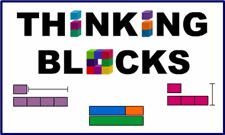 Thinking
Blocks at Math Playground teaches students in grades 1-7 how to visualize and solve math word problems. Using
interactive blocks and cubes, they create models that illustrate the
underlying math concepts within the problems. Skills include addition,
multiplication, fractions, ratios, and there is a modeling tool for students to develop strong problem solving skills.
Thinking
Blocks at Math Playground teaches students in grades 1-7 how to visualize and solve math word problems. Using
interactive blocks and cubes, they create models that illustrate the
underlying math concepts within the problems. Skills include addition,
multiplication, fractions, ratios, and there is a modeling tool for students to develop strong problem solving skills.
Visual Patterns contains nearly 500 patterns to encourage mathematical thinking. Those who try the patterns look for what the pattern would be at the 43 step and then determine an equation associated with the pattern.
 Students
might not be aware of how much math plays in their daily lives, nor
in the entertainment they experience.
Students
might not be aware of how much math plays in their daily lives, nor
in the entertainment they experience.
Become an avid reader of Plus magazine-- a real find of value!
Plus is an internet magazine which is free for educational and non-commercial purposes. It aims to introduce readers to the beauty and the practical applications of mathematics. You'll find "articles, which describe applications of maths to real-world problems, games, and puzzles; reviews of popular maths books and events; a news section, showing how recent news stories were often based on some underlying piece of maths that never made it to the newspapers; a puzzle for you to sharpen your wits against; a lucky dip of mathematical curiosities; and opinions on various maths-related topics and news stories. [Plus also has] a regular interview with someone in a maths-related career, showing the wide range of uses maths gets put to in the real world." (About Plus section)
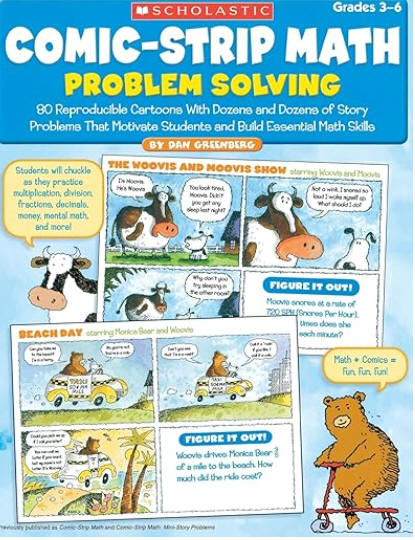 Young learners in grades 3-6 will appreciate
Comic-Strip Math: Problem Solving
by Dan Greenberg (2010). They'll laugh as they read each of the 80
comic strips and complete companion mini-story problems. They'll
reinforce skills in place value and rounding, number operations, fractions,
decimals, time, money, measurement, geometry, graphs, patterns, rate, ratio,
probability and statistics.
Young learners in grades 3-6 will appreciate
Comic-Strip Math: Problem Solving
by Dan Greenberg (2010). They'll laugh as they read each of the 80
comic strips and complete companion mini-story problems. They'll
reinforce skills in place value and rounding, number operations, fractions,
decimals, time, money, measurement, geometry, graphs, patterns, rate, ratio,
probability and statistics.
Add some enrichment with Mathematics in Movies, a collection of clips in which mathematics appears gathered by Oliver Knill of the Mathematics Department of Harvard University. The collection is extensive ranging from Alice in Wonderland to the Simpsons, Shrek the Third, A Walk to Remember, and so much more. Teachers should preview selections for age appropriateness. For example, Die Hard is also in the collection and the language might not be suitable for some.
Viewers of the TV series Simpsons might not be aware of all the math one can find in several of the episodes. There are "over a hundred instances of mathematics ranging from arithmetic to geometry to calculus, many designed to expose and poke fun at innumeracy." The popularity of the Simpsons makes simpsonsmath.com an "ideal source of fun ways to introduce important concepts to students, and to reduce math anxiety and motivate students in courses for non-majors." Drs. Sarah Greenwald and Andrew Nestler also provide resources for using the site with students.
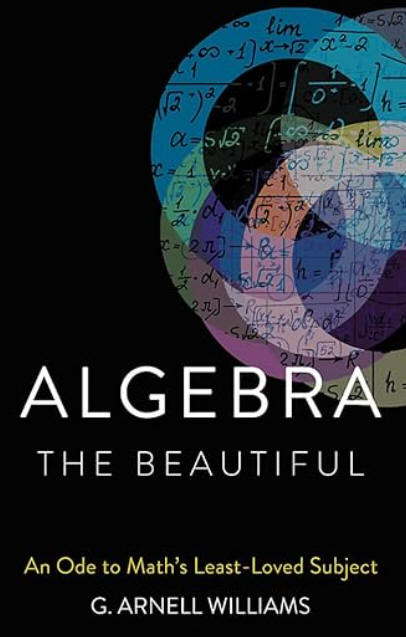 Algebra the Beautiful: An Ode
to Math’s Least-Loved Subject (2022) by G. Arnell Williams has a
wide range of appeal and illustrates there is fun in algebra.
Per its description, "Williams blends metaphor, history, and
storytelling to uncover algebra’s hidden grandeur. Whether you’re a
teacher looking to make math come alive for your students, a parent
hoping to get your children engaged, a student trying to come to
terms with a sometimes bewildering subject, or just a lover of
mathematics, this book has something for you."
Algebra the Beautiful: An Ode
to Math’s Least-Loved Subject (2022) by G. Arnell Williams has a
wide range of appeal and illustrates there is fun in algebra.
Per its description, "Williams blends metaphor, history, and
storytelling to uncover algebra’s hidden grandeur. Whether you’re a
teacher looking to make math come alive for your students, a parent
hoping to get your children engaged, a student trying to come to
terms with a sometimes bewildering subject, or just a lover of
mathematics, this book has something for you."
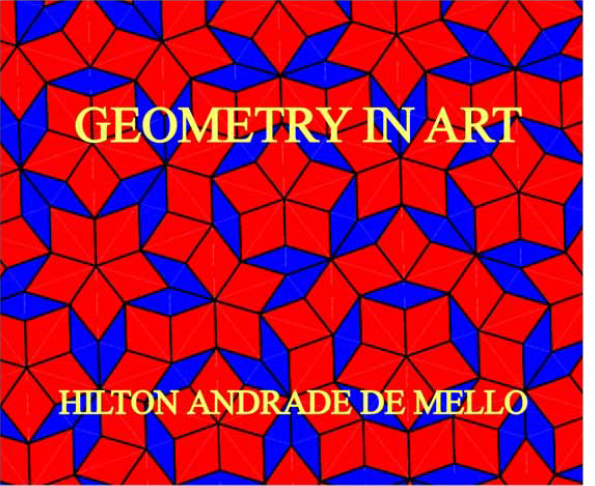 Geometry in Art (2010) by Hilton Andrade de Mello of Brazil
is an excellent supplementary book for students to explore
"how geometric forms have been and continue to be used in the
Arts and in Architecture, and also how they appear in Nature." You'll read
analyses of the role of geometry in actual works of art. In writing this book, which is a free
download, the author received contributions from artists around the
world. Ten chapters address Abstraction and Geometry, Planar
geometric forms, Polyhedrons, Other spatial figures such as the
conics, Composing a canvas with polygons: Tessellations,
Perspective, The Golden Ratio, Symmetry and specular image, Geometry
and symbolisms, and an Introduction to Informatics and the arts.
Geometry in Art (2010) by Hilton Andrade de Mello of Brazil
is an excellent supplementary book for students to explore
"how geometric forms have been and continue to be used in the
Arts and in Architecture, and also how they appear in Nature." You'll read
analyses of the role of geometry in actual works of art. In writing this book, which is a free
download, the author received contributions from artists around the
world. Ten chapters address Abstraction and Geometry, Planar
geometric forms, Polyhedrons, Other spatial figures such as the
conics, Composing a canvas with polygons: Tessellations,
Perspective, The Golden Ratio, Symmetry and specular image, Geometry
and symbolisms, and an Introduction to Informatics and the arts.
Geometry Playground, created by the Exploratorium in San Francisco, will change how you view geometry in nature. It contains three sections: The Geometry of Seeing with a photo exhibition of the invisible geometry of light; The Geometry of Moving on the arcs, angles, and shapes created when people and things are in motion; and the Geometry of Fitting Things Together. Each includes hands-on activities for grades K-8. The Geometry Garden features curiosities found in nature from crystals to seashells to sculptures. The site was made possible by the National Science Foundation and the Gordon and Betty Moore Foundation.
The Mathematical Association of America hosts the Found Math Galleries, which feature interesting photos involving math: the ordinary sidewalk, symmetry in nature, architectural wonders--just look around you. This will give great inspiration for your students to take their own photos of math in daily life--what a great project idea!
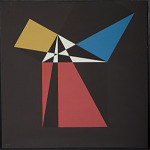 The Natural Museum of American History features 80 of the
Mathematical Paintings of Crockett Johnson. "From 1965
until his death in 1975 Crockett Johnson painted over 100 works
relating to mathematics and mathematical physics." Many relate to
the geometric figures and concepts that students encounter in their
high school math courses, and give great inspiration for projects
linking math to art. The image shown is Crockett Johnson's
1965 Painting: Proof of the Pythagorean Theorem (Euclid).
Image credit from the website.
The Natural Museum of American History features 80 of the
Mathematical Paintings of Crockett Johnson. "From 1965
until his death in 1975 Crockett Johnson painted over 100 works
relating to mathematics and mathematical physics." Many relate to
the geometric figures and concepts that students encounter in their
high school math courses, and give great inspiration for projects
linking math to art. The image shown is Crockett Johnson's
1965 Painting: Proof of the Pythagorean Theorem (Euclid).
Image credit from the website.
View The Great Math Mystery (2015, about 50 minutes) from PBS.org. Per the program description:
"Join NOVA on a mathematical mystery tour—a provocative exploration of math's astonishing power across the centuries. We discover math's signature in the swirl of a nautilus shell, the whirlpool of a galaxy, and the spiral in the center of a sunflower. Math was essential to everything from the first wireless radio transmissions to the prediction and discovery of the Higgs boson and the successful landing of rovers on Mars. Astrophysicist and writer Mario Livio, along with a colorful cast of mathematicians, physicists, and engineers, follow math from Pythagoras to Einstein and beyond. It all leads to the ultimate riddle: Is math a human invention or the discovery of the language of the universe?"
 You can get
paper models of polyhedra (i.e., the nets
for construction) for several hundred different polyhedrons (e.g., tetrahedron, hexahedron,
octahedron, dodecahedron, icosahedron) at
https://www.polyhedra.net/en/. Then print, cut, fold, and glue
your 3D models. The image shown is called a small stellated
dodecahedron.
You can get
paper models of polyhedra (i.e., the nets
for construction) for several hundred different polyhedrons (e.g., tetrahedron, hexahedron,
octahedron, dodecahedron, icosahedron) at
https://www.polyhedra.net/en/. Then print, cut, fold, and glue
your 3D models. The image shown is called a small stellated
dodecahedron.
Discrete Mathematics in the Real World contains short and longer descriptions of everday applications (e.g., computers binary math, networks and routers, web searches, Google maps, area codes, bankruptcy proceedings, cell phone communications, etc.) and interesting research and corporate applications (e.g., medical imaging, logistics, cybersecurity, 3D imaging, etc). This is a great start to knowing the value of discrete mathematics and its role.
Wikipedia: Discrete Mathematics illustrates where discrete mathematics is found in a variety of topics, such as computer science, logic, set theory, combinatorics, graph theory, probability, number theory, calculus, geometry, topology, game theory, and more.
Back to top | Math Resources: Page 1 | 2 | 3 | 4 | 5 | 6
Boodhoo, N. (2012, July 10). For manufacturing jobs, workers brush up on math. https://www.npr.org/2012/07/10/155837962/for-manufacturing-jobs-workers-brush-up-on-math
Cheng, A. K. (2001). Teaching mathematical modelling in Singapore schools. The Mathematics Educator, 6(1). https://web.archive.org/web/20181125053207/http://math.nie.edu.sg/kcang/TME_paper/teachmod.html
Council for Economic Education & Jump$tart Coalition. (2021). National standards for personal finance education. https://www.jumpstart.org/what-we-do/support-financial-education/standards/
Depersio, G. (2020, September 25). Data analyst: Career path & qualifications. https://www.investopedia.com/articles/professionals/121515/data-analyst-career-path-qualifications.asp
Ellis, M. (2015). Mastering the most challenging math standards with rigorous instruction [Whitepaper]. North Billerica, MA: Curriculum Associates. http://www.casamples.com/downloads/Mastering-Most-Challenging-Math-Standards.pdf
Fisher, D., & Frey, N. (2023). Disciplinary literacy as social justive. Educational Leadership, 80(8). https://www.ascd.org/el/articles/disciplinary-literacy-as-social-justice
Ginsburg, D. (2016, March 28). Four purposes of math problems. Education Week. https://www.edweek.org/teaching-learning/opinion-four-purposes-of-math-problems/2016/03
Gould, H., Murray, D., & Sanfratello, A. (2012). Mathematical modeling handbook (sample). Bedford, MA: The Consortium for Mathematics and Its Applications. https://web.archive.org/web/20220128003936/https://www.comap.com/modelingHB/Modeling_HB_Sample.pdf
Kasman, M., Heuberger, B., & Hammond, R. (2018). Recommendations for improving youth financial literacy education. Washington, DC: The Brookings Institution. https://www.brookings.edu/wp-content/uploads/2018/10/ES_20181001_Financial-Literacy-Recommendations.pdf
Malouff, J. (2018). Over 50 problem solving strategies explained. University of New England Blog. https://blog.une.edu.au/usingpsychology/2018/10/15/over-fifty-problem-solving-strategies-explained/
McTighe, J., & Wiggins, G. (2013). Essential questions: Opening doors to student understanding. Alexandria, VA: ASCD.
Moursund, D. (2016). Math problem-based learning. http://web.archive.org/web/20210421224319/http://iae-pedia.org/Math_Problem-based_Learning
Roh, K. H. (2003). Problem-based learning in mathematics. ERIC Digest (ED482725). https://files.eric.ed.gov/fulltext/ED482725.pdf
Seeley, C. (2017). Turning teaching upside down. Educational Leadership, 75(2), 32-36. https://www.ascd.org/el/articles/turning-teaching-upside-down
U.S. Bureau of Labor Statistics. (2020). Math occupations. https://www.bls.gov/ooh/math/home.htm
Zeitz, P. (2007). The art and craft of problem solving (2nd edition). http://www.gang.umass.edu/~franz/Paul_Zeitz_The_Art_and_Craft_of_Problem_SolvingBookosorg.pdf
Back to top | Math Resources: Page 1 | 2 | 3 | 4 | 5 | 6
![]() See
related topics: Math Manipulatives
and Standardized Test
Preparation.
See
related topics: Math Manipulatives
and Standardized Test
Preparation.